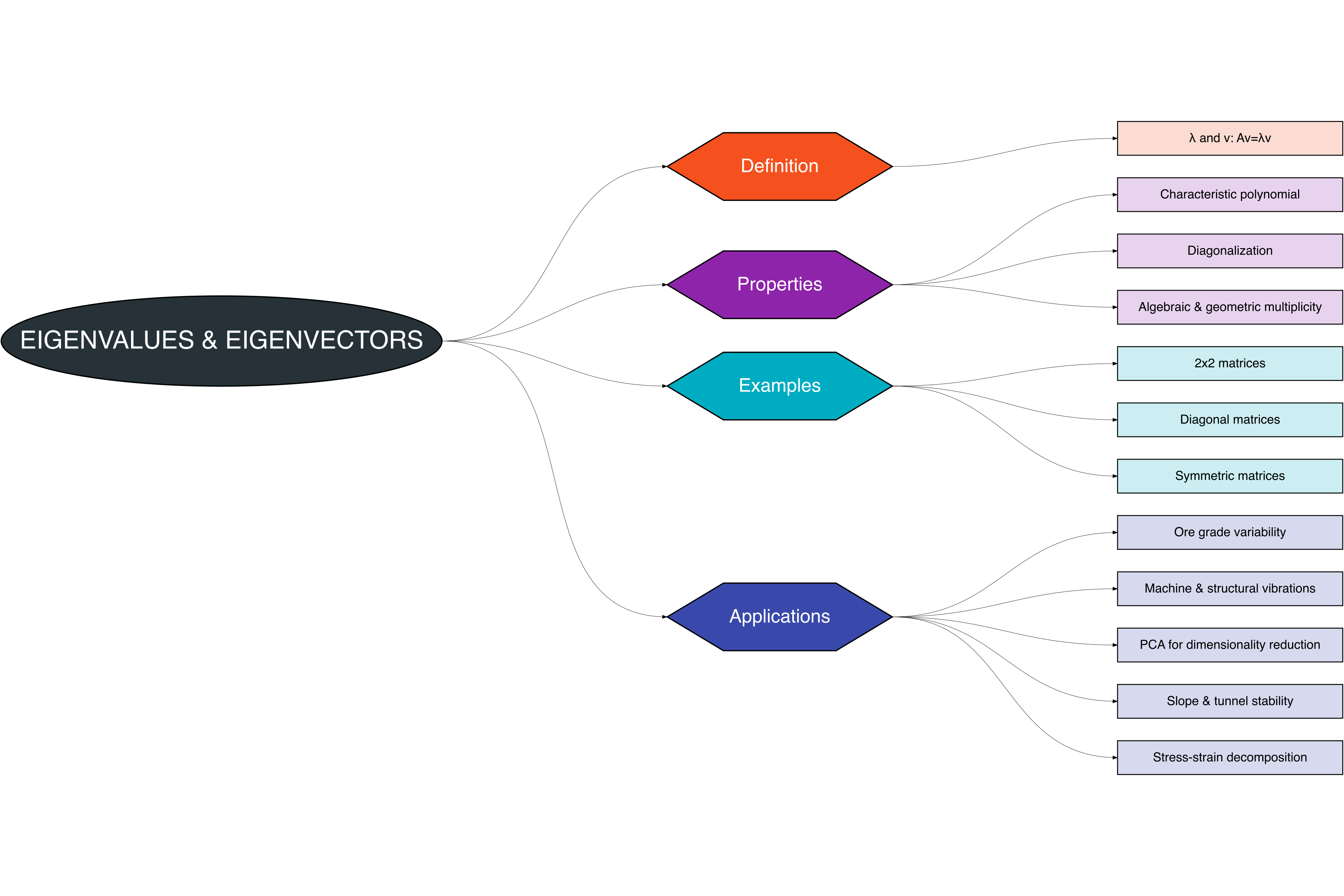
9 Eigenvalues
In this chapter, we explore the concept of eigenvalues and eigenvectors, their properties, and applications. A mind map provides a structured overview of the key topics discussed:

Eigenvalues and eigenvectors are fundamental concepts in linear algebra. For a linear transformation represented by a matrix \(A\), an eigenvector \(v\) satisfies:
\[ A v = \lambda v \]
where \(\lambda\) is the eigenvalue associated with \(v\). Eigenvalues describe scaling factors along certain directions (eigenvectors) and are central to understanding the behavior of linear systems.
In the context of mining engineering:
- Ore Grade Variability: Eigenvectors can identify principal directions of variation in ore properties, and eigenvalues quantify the magnitude of these variations chiles2012?.
- Machine & Structural Vibrations: Vibration modes of mining equipment or tunnels correspond to eigenvectors, with eigenvalues representing frequencies, aiding maintenance and safety analysis [1].
- Principal Component Analysis (PCA): Eigenvectors of the covariance matrix determine principal components, enabling dimensionality reduction of ore grade datasets while preserving maximum variance [1].
- Slope & Tunnel Stability: Eigenvalue analysis of stiffness or stress matrices helps predict failure directions and magnitudes, improving safety and design meyer2000?.
- Stress-Strain Decomposition: In rock mechanics, eigenvectors of the stress tensor indicate principal stress directions, and eigenvalues quantify stress magnitude for modeling and simulation rubinstein2016?.
9.1 Definition
An eigenvector \(v \neq 0\) of a square matrix \(A\) satisfies:
\[ A v = \lambda v \]
where \(\lambda\) is the corresponding eigenvalue.
- Eigenvectors define directions preserved by the transformation.
- Eigenvalues define scaling factors along these directions.
9.2 Properties
Characteristic Polynomial:
\[ \det(A - \lambda I) = 0 \]
Solutions \(\lambda\) are eigenvalues of \(A\).Diagonalization:
If \(A\) has \(n\) linearly independent eigenvectors, \(A\) can be written as:
\[ A = P D P^{-1} \]
where \(D\) is a diagonal matrix of eigenvalues and the columns of \(P\) are the corresponding eigenvectors.Multiplicity:
- Algebraic multiplicity: Number of times an eigenvalue appears as a root.
- Geometric multiplicity: Dimension of the eigenspace corresponding to the eigenvalue.
- Algebraic multiplicity: Number of times an eigenvalue appears as a root.
9.3 Examples
2x2 Matrix:
\[ A = \begin{bmatrix} 4 & 1 \\ 2 & 3 \end{bmatrix} \]Diagonal Matrix: Eigenvalues are the diagonal entries, and eigenvectors are standard basis vectors.
Symmetric Matrix: Real eigenvalues with orthogonal eigenvectors.
9.4 Applications
- Ore Grade Analysis: Identify principal directions of variability and correlations between ore properties.
- Vibration Analysis: Determine natural frequencies and mode shapes of mining equipment or structures.
- PCA for Ore Data: Reduce dimensionality while preserving variance for geostatistical modeling.
- Stability Analysis: Assess slope, tunnel, or foundation stability using eigenvalue decomposition of stiffness matrices.
- Stress-Strain Modeling: Decompose stress tensors to identify principal stresses and directions in rock mechanics.
